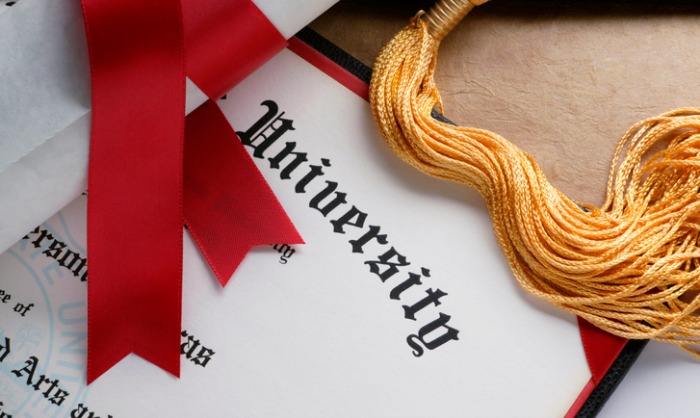Every week, Liaison’s Highlights from Higher Ed blog post series summarizes news and research reports about important topics affecting admissions professionals, institutional leaders, students and other stakeholders in the world of higher education. Reviewing the top stories of 2019, we noticed that several themes consistently merited attention and discussion. Here’s an overview of those topics and a sampling of articles published this year that covered them.
1. Declining Interest Among International Applicants
Whether you blame federal immigration policies, increased competition from foreign schools, high costs or fractious civil discourse here at home (or a combination of all those factors), there’s no denying that the United States is losing ground when it comes to attracting and enrolling foreign students.
Foreign Student Enrollment Not Entirely the President’s Fault
March 2019 — Forbes
For the past few years, international student enrollment and application numbers have gone down. While some students have noted the U.S. President’s position on immigration as a reason, there are others. One such reason is the cost of higher education in the U.S. The average annual tuition amount in the U.S. is $8,202 at public schools and $21,189 at private schools. By contrast, the average tuition in South Korea, for example, is less than $5,000 for public and $8,500 for private, which plays into the decision process for students looking to come to the U.S.
International Drop Continues
April 2019 — Poets & Quants
After three years of declining international student enrollment, business schools in the United States can officially call it a trend. And while this shift seems to be affecting nearly everyone, certain types of institutions appear to be bearing the brunt of it. For example, some southern schools are showing enrollment declines in excess of 20%, while several top schools reported declines averaging 6.5% in recent years. Thirty-six schools with full-time MBA programs saw declines from 2016 to 2018, and another 32 saw a decline in the past year. Additionally, in 2016 there were two schools with more than half of their MBA student population made up of international students; in 2017, they had no international students.
Colleges Fear Losing International Students Over Visa Delays
July 2019 — Education Dive
Leaders at many institutions, including Harvard, Princeton, Yale and MIT, are concerned about the enrollment of their admitted international students. In order to address this, they wrote to the Department of Homeland Security (DHS), “urging them to expedite visa issuances by the USCIS or else face a precipitous decline in the flow of international talent to the U.S. in the years to come.” Overall enrollment of new international students and new graduate enrollment students in U.S. colleges has been on a downward spiral since peaking in 2015-16. New enrollment of international undergrads fell by 2.9% in 2016-17 and fell by 6.9% the following year. Graduate-level new enrollments declined by 6.8% from a high point in 2015-16 to 2017-18, according to the Institute of International Education.
2. The Admissions Scandal and Privilege
The involvement of several high-profile Hollywood celebrities ensured that the so-called “Varsity Blues” admissions scandal would capture the attention of millions of Americans who might not otherwise care much about college admissions practices. It also fueled a new debate about the role privilege plays in deciding which students receive acceptance letters from schools.
A Surprising Number of People Involved in Admissions Fraud, but Public Not Surprised
April 2019 — The Chronicle of Higher Ed
The public was not shocked to hear of the recent admissions scandal, and most people aren’t entirely interested in who’s to blame. But it is important to note that of the 50 individuals who allegedly participated and were charged, none of them worked in admissions. Coaches and exam proctors — those who appear to play a bigger role in admissions than the public generally realized — are the ones who were allegedly receiving bribes. Ultimately, however, the scandal revolves around admissions — and the public wants admissions departments to step up and address the underlying problems.
The College Admissions Scandal Thrusts Test Time Limits Into the Spotlight
April 2019 — The Atlantic
The college admissions scandal brought renewed attention to one of the strategies reported to have been exploited by its alleged perpetrators: abusing extended-time accommodations on standardized tests. Giving students more time on tests is standard practice under the Americans with Disabilities Act. The amount of time provided in an extension varies based on the student, but the SAT generally allows for extensions of up to 100% of the allotted time. Those who oppose standardized tests strongly believe that a time-limited test is a poor measurement of the knowledge and abilities colleges want to assess in applicants.
Colleges Begin to More Closely Scrutinize Application Materials
November 2019 — Bloomberg
Several U.S. colleges and universities are “stepping up scrutiny of student applications” after the recent scandal involving the discovery of widespread cheating in the admissions process by applicants and parents. Yale University, Bowdoin College and Pomona College are among those institutions that have announced plans to spot-check information submitted with applications more aggressively. Yale, for example, “will verify some extracurricular accomplishments and awards, and audit a number of applicants’ applications at the end of each admissions cycle.” At Pomona, “coaches are being asked to provide third-party backing of an athlete’s talent, such as a web link to rankings or a local newspaper story.” In addition, “the school’s admissions officers may conduct additional research on one out of every 40 to 50 applicants when they include unfamiliar activities.”
Judge Sides with Harvard
October 2019 — The New York Times
A federal judge ruled that Harvard could continue to consider a student’s race in its admissions process in its aspiration to curate a diverse class. Plaintiffs pointed out that Asian-American applicants steadily performed lower in Harvard’s personal ratings than other races. The judge acknowledged this disparity but found it to be too small to reflect intentional discrimination. Harvard has since updated its admissions procedures. For example, it changed the personal rating criteria for students and directed officers to consider the race or ethnicity of a student as one factor among many.
3. Holistic Reviews vs. Standardized Testing
In addition to considering coursework grades, should colleges and universities admit students based on standardized test scores, holistic reviews or a combination thereof? Everyone seems to have an opinion, but that doesn’t mean there’s a clear consensus.
The Holistic Holdup for Some Nursing Programs
February 2019 — Kira Talent
Health professions programs are leading the way in the holistic admissions process, with 93% of dental schools and 91% of medical schools already using a holistic process to admit students. Nursing schools, on the other hand, have been a little hesitant to adopt holistic admissions practices. The most common reasons cited include fear of potentially possessing a subconscious bias, not having enough time to change the process and a lack of strong evidence to suggest that it will be successful.
New Holistic Project Funded
February 2019 — UC Davis
The Andrew W. Mellon Foundation provided a grant of $1,195,000 to UC Davis, UCLA and USC to fund a 4½-year holistic review project. The project is focused on developing holistic review methods for eight humanities and humanistic social science graduate programs at each UC campus. “We are excited because, ultimately, this project has the potential not only to reach across our 10-campus system but also to reach peer institutions nationwide,” said Prasant Mohapatra, principal investigator for the project and vice provost for Graduate Education and dean of Graduate Studies at UC Davis.
College Board Scraps Planned Adversity Score
September 2019 — Diverse Education
The College Board withdrew its proposal to create an adversity score, which was “meant to put SAT results in the context of students’ life challenges.” Instead, a new scoring system to assess applicants will analyze multiple metrics to understand students’ backgrounds instead of just one number. For example, data about students’ neighborhoods — such as geographic location, median household family income and crime rates — will be taken into account, as well as information about class size, the number of advanced placement classes taken, etc. The original plans for an adversity score would only “rate students on a scale of 1 to 100, based on information about students’ neighborhoods and their socioeconomic backgrounds.” The College Board’s CEO said the new plan “provides admissions officers with more consistent background information so they can fairly consider every student, no matter where they live and learn.”
More Colleges Go Test-Optional
May 2019 — Inside Higher Ed
Several schools — including the University of San Francisco and Springfield College — announced they would no longer require applicants to submit SAT or ACT scores. Some graduate programs are also dropping test requirements. For example, the University of Michigan’s history department no longer requires students applying to its doctoral program to submit GRE scores. A handful of programs at the University of Pennsylvania, Cornell University and Harvard University have also done away with GRE requirements.
4. Questions About the Value of Higher Education
In light of a strong economy and job market, plus concerns about the potentially significant costs of post-secondary education, some people believe the allure of earning a diploma or advanced degree is now diminished. That, in turn, inspires concerns about being able to attract best-fit students into the classroom.
Liberal Arts Degree — Still Worth It
March 2019 — Inside Higher Ed
A pair of economists at the Andrew W. Mellon Foundation suggested that a liberal arts degree is still worth the cost. While it may not garner as much income as an engineering degree, it still leads to economic mobility and profitability. Their study showed that the top degree obtained by those who study at a non-liberal arts school is engineering, but the rest of the STEM degrees awarded are from liberal arts colleges. In terms of economic payoff, more than 60% of the liberal arts graduates surveyed found themselves in the top two quintiles of income. The study also included an analysis of graduation rates and the availability of financial aid.
Students Identify Their Most- and Least-Regretted Majors
December 2019 — CNBC
Job-seeking college graduates who majored in English or foreign languages are most likely to say they regret what they chose to study (42%), due to “impractical, limited job opportunities.” Those who majored in math or computer science are the least likely to regret their majors, with just 13% citing “stressful industry, limited job opportunities.” Second on the list of most-regretted majors is the sciences (35%), followed by education (31%), social sciences/law (29%) and communications (27%). The second least-regretted majors are business and engineering (both 16%), followed by health administration/assisting (18%). Three majors register a 19% regret rate: community/family/personal services, health sciences/technology and repair/production/construction.
Is the MBA’s Average Six-Figure Debt Worth It?
July 2019 — Poets & Quants
Bloomberg Businessweek researchers surveyed over 10,000 2018 MBA graduates from 126 business schools around the world. They found about 40% of respondents who received “MBAs from Duke University’s Fuqua School of Business, Tuck School of Business at Dartmouth College, University of Michigan’s Ross School of Business, SC Johnson Graduate School of Management at Cornell University, and University of Chicago Booth School of Business reported graduating with six-figure debt.” Particularly notable responses include 47% at Fuqua and 46% at Dartmouth Tuck. Shahien Nasiripour, of Bloomberg Businessweek, believes these “survey results shed new light on the amount of debt that aspiring executives and entrepreneurs take on to jump-start their careers with a credential prized by the nation’s leading financial institutions, consultancies and corporations.” Despite the six-figure debt that a large number of MBA grads accumulate, many say the degree is an investment that still holds value. However, they also note that some schools offer better ROI than others.
Business Schools Need to Better Articulate the Benefits of Graduate Management Education
December 2019 — Boston Business Journal
Forward-thinking GME program directors and admissions professionals are responding to enrollment challenges at their institutions by identifying new opportunities for success, such as leveraging as much data as possible in order to understand current trends in a broader, more meaningful context. Still, business schools must do a better job of articulating the benefits of graduate management education, such as the career opportunities it makes possible and the return on investment it provides. Ultimately, the power of data — and visionary leadership — will make it possible to maintain an optimistic view of the future of graduate management education, regardless of the headwinds we may encounter from time to time.
Can Business School Leaders Learn From Dairy Farmers?
December 2019 — BizEd
Citing widespread declines in GME application volume, Shaun R. Carver, assistant dean of graduate programs at the University of California, San Diego’s Rady School of Management, wrote that “the shrinking market for GME mirrors the plight of dairy farmers in the 1990s.” He went on to suggest that: “Just as small-scale dairy farmers don’t possess the power to move the dairy market, today’s individual business schools in any country don’t have the resources or influence to reverse the migration away from traditional MBA programs among the entire population of prospective applicants. But business schools could move the needle if they acted in unison, with an inspired and creative message at the heart of their concerted campaign.” His solution is to “borrow a page from the playbook of the American dairy farmers of the 1990s” and emulate their iconic “Got Milk?” advertising campaign for the benefit of the entire GME community. That would involve business schools working together to come up with a “game-changing” slogan, pooling their resources to disseminate advertisements and then “inserting their own program’s story within the template provided by the broader GME campaign.”
5. Reaching the Next Generation
It’s an age-old question: What’s up with the youth of today? Of course, they’d probably say that simply asking that question proves how old and out of touch we are. Still, the search for answers continues.
What Do High School Students Want From College Tours?
April 2019 — Inside Higher Ed
A group of counselors speaking at the annual meeting of the American Association of Collegiate Registrars and Admissions Officers offered insights into what California high school students expect and value when visiting schools. Not surprisingly, high school students and 18-year-olds, in particular, are fickle and unpredictable. But when it comes to college tours, they are generally more likely to remember their tour guide than the tour itself. They want customized information, not generic talks from college reps. And they want to know what it’s like to attend the school they are visiting, which they expect to hear about from their tour guides.
Instagram Introductions
April 2019 — The Atlantic
For today’s high school graduates, Instagram is the way to meet people – before even arriving for freshman orientation. Class-specific Instagram accounts — with names like @penn2023 and @AUclassof2023 — are the forums where incoming freshmen are meeting their roommates, asking questions, making friends and learning about their new schools. By contrast, most of today’s high schoolers and incoming freshmen don’t use Facebook. For admissions counselors, becoming Instagram savvy is a great way to interact with students before they arrive on campus in the fall.
Snapchat for Admissions Marketing?
May 2019 — DigiDay
Snapchat added four million new users in the first quarter of 2019, pushing the number of its daily users to 190 million. The multimedia messaging app now reaches 75% of all U.S. residents aged 13 to 34. Because this group includes most prospective undergraduate and graduate students, admissions officials may want to consider increasing their Snapchat presence. Institutions eager to boost international enrollment should also take note of Snapchat’s growth: more than half of the app’s daily users are located outside of North America.
6. Women Make Strides in MBA Classrooms
The number of women in GME classrooms increased in 2019 — yet even that silver lining is clouded, as women are still not experiencing a fair share of the benefits they deserve in the nation’s boardrooms.
Women’s Gains on Campus Aren’t Matched in the Workplace
December 2019 — Diverse Education
The Forté Foundation, which represents 54 leading GME programs in the United States, Europe and Canada, reported that the number of women enrolling in MBA programs at Forté-affiliated schools is increasing. Women now account for 39 percent of the full-time MBA student population in the U.S. and 36 percent outside of the U.S. Yet, according to Robert Ruiz, Managing Director of Liaison’s BusinessCAS, “those gains are not being matched in the workforce in the form of equal opportunity and equal reward. And it’s not just women who are being denied the chance to benefit from the skills they possess: Society as a whole suffers when inequity is allowed to persist.” In an online piece posted by Diverse Education, Ruiz noted that only 5.2% of S&P 500 CEOs are women and that women continue to face a significant pay gap even after receiving an MBA. According to Ruiz, “by striving for greater gender equality in their MBA programs, today’s GME leaders can help business schools overcome the challenge of declining interest among applicants while simultaneously championing a prosocial mission.”
7. Competition Concerns Cloud the Future
The last item on our list has more to do with the years ahead than the year behind us.
Increasing and “New Forms” of Competition Tops the List of Higher-Ed Leaders’ Concerns
December 2019 — Huron Consulting Group
Researchers working with the American Council on Education and the Georgia Institute of Technology asked nearly 500 public and private higher education leaders to identify which market trends will have the biggest impact on their institutions in the next five years. The most common response, cited by 62%, was “increasing/new forms of competition for prospective students.” The list of top-five concerns also includes:
- declining traditional-age student population (59%).
- increasing nontraditional student population (39%).
- declining federal and state financial support (38%).
- declining public confidence in the value of higher education (27%).
- geopolitical uncertainty affecting international students (23%).
It’s worth noting, however, that responses provided by public and private officials often differed significantly. For example, declining financial support is a cause of concern for 63% of the latter but only 20% of the former; a decline in the number of traditional age-students worries 50% and 66%, respectively.
For ongoing insights into the most important developments in the world of higher education, be sure sure to follow Liaison’s Highlights from Higher Ed blog series, which publishes a new post every week. And to learn more about how Liaison can help your institution achieve its most critical admissions and enrollment goals, contact us today.







